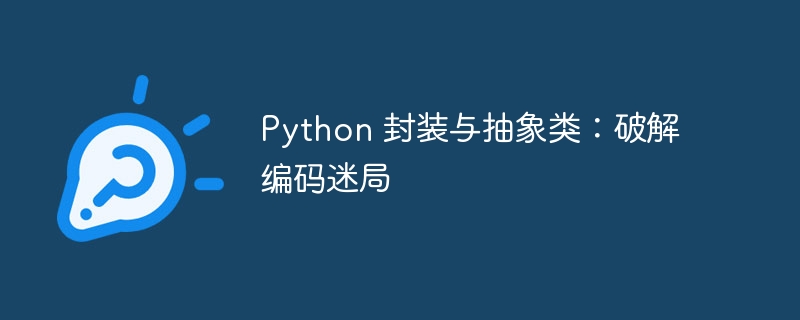Home >Backend Development >Python Tutorial >Python encapsulation and abstract classes: cracking the coding puzzle
Python encapsulation and abstract classes: cracking the coding puzzle
- 王林forward
- 2024-03-21 12:01:02695browse

python Encapsulation and abstract classes are the basic concepts of Object-oriented programming## (OOP) and are used to organize and manage code to improve code readability, reusability and maintainability.
EncapsulationEncapsulation is a technique that hides implementation details and exposes only necessary interfaces. In
Python, encapsulation is implemented using private properties and methods. Private properties and methods begin with a double underscore (__) and are accessible only to the class and its subclasses.
Enhance the code
- Security
- : Restrict access to sensitive data. Improve maintainability: allow modification of implementation details without affecting external code.
- Promote loose coupling: reduce dependencies between classes.
class Person: def __init__(self, name): self.__age = 0# Private property self.name = name def get_age(self): return self.__age def set_age(self, age): if age < 0: raise ValueError("Age cannot be negative") self.__age = age
Abstract classAbstract class is a base class that defines a set of concrete methods and abstract methods. Concrete methods are implemented in the base class, while abstract methods are only declared but not implemented. Abstract methods must be implemented in derived classes.
use:Define a common interface for subclasses.
- Prevent the creation of instances that cannot use all required methods.
- Promote code reuse and extensibility.
Use
- @abstractmethod
- decorator to mark abstract methods.
- class in the
abcmodule as the base class. - will be raised.
from abc import ABCMeta, abstractmethod class Shape(metaclass=ABCMeta): @abstractmethod def get_area(self): class Rectangle(Shape): def __init__(self, length, width): self.length = length self.width = width def get_area(self): return self.length * self.width
The relationship between encapsulation and abstract classesEncapsulation and abstract classes can be used together to improve code organization and maintainability. An abstract class defines a public interface, while encapsulation hides the internal state of the class and exposes only the necessary interfaces. This prevents external code from directly accessing internal state, while still allowing subclasses to access and modify that state.
advantage:Enhance code security: Hide sensitive data through encapsulation.
- Improve reusability: define a common interface through abstract classes.
- Promote code maintainability: By separating interfaces and implementations, the code is easy to modify and extend.
Python's encapsulation and abstract classes are powerful
toolsfor building flexible, reusable, and maintainable code. By hiding implementation details and defining public interfaces, they can help organize code, reduce coupling, and improve the overall quality of the code.
The above is the detailed content of Python encapsulation and abstract classes: cracking the coding puzzle. For more information, please follow other related articles on the PHP Chinese website!

